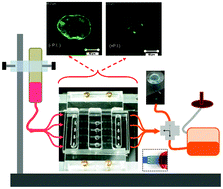We have developed a novel, portable, gravity-fed, microfluidics-based platform suitable for optical interrogation of long-term organotypic cell culture. This system is designed to provide convenient control of cell maintenance, nutrients, and experimental reagent delivery to tissue-like cell densities housed in a transparent, low-volume microenvironment. To demonstrate the ability of our Thick-Tissue Bioreactor (TTB) to provide stable, long-term maintenance of high-density cellular arrays, we observed the morphogenic growth of human mammary epithelial cell lines, MCF-10A and their invasive variants, cultured under three-dimensional (3D) conditions inside our system. Over the course of 21 days, these cells typically develop into hollow “mammospheres” if cultured in standard 3D Matrigel. This complex morphogenic process requires alterations in a variety of cellular functions, including degradation of extracellular matrix that is regulated by cell-produced matrix proteinases. For our “drug” delivery testing and validation experiments we have introduced proteinase inhibitors into the fluid supply system, and we observed both reduced proteinase activity and inhibited cellular morphogenesis. The size inhibition results correlated well with the overall proteinase activities of the tested cells.

You have access to this article
 Please wait while we load your content...
Something went wrong. Try again?
Please wait while we load your content...
Something went wrong. Try again?


 Please wait while we load your content...
Please wait while we load your content...